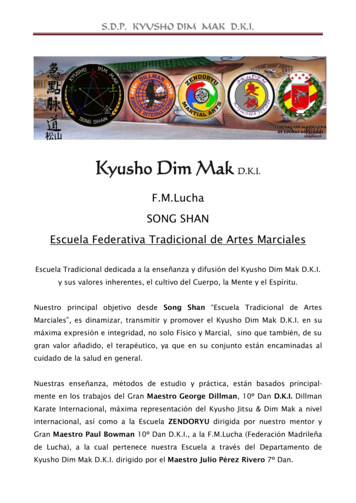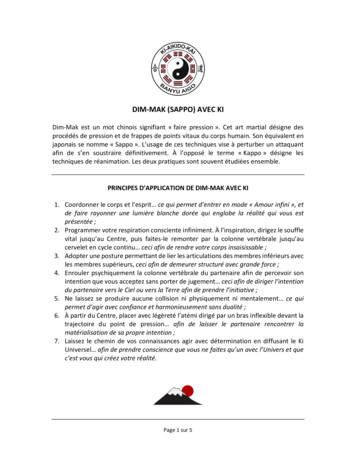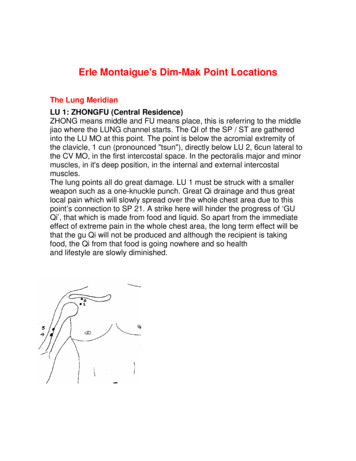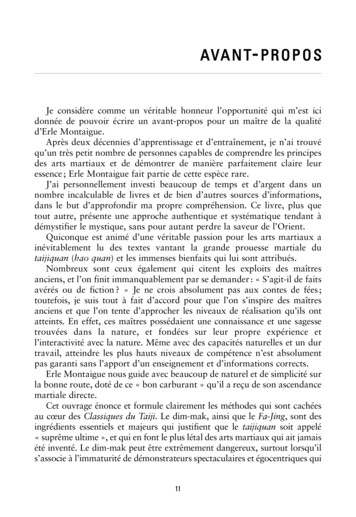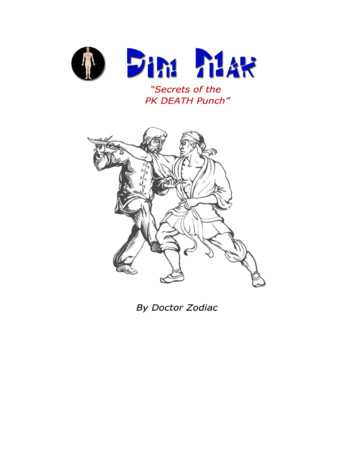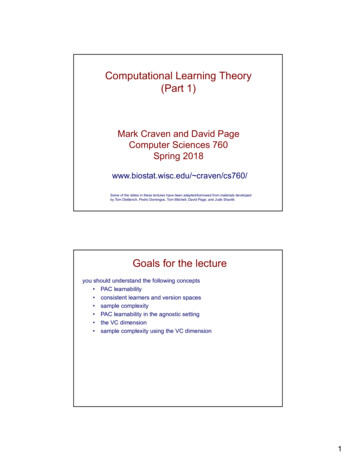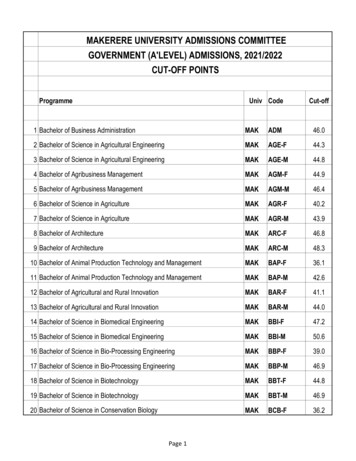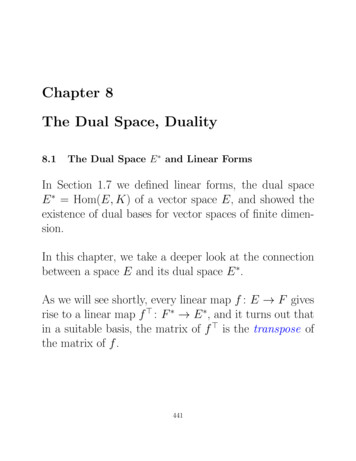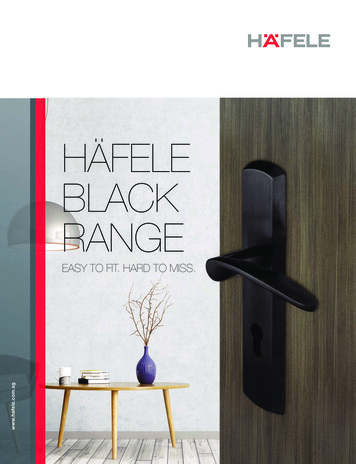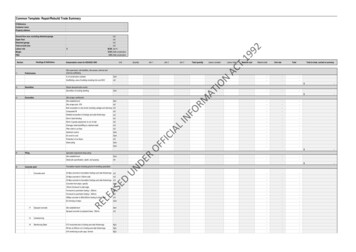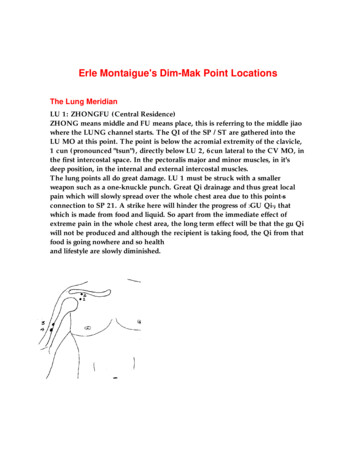
Transcription
Erle Montaigue's Dim-Mak Point LocationsThe Lung MeridianLU 1: ZHONGFU (Central Residence)ZHONG means middle and FU means place, this is referring to the middle jiaowhere the LUNG channel starts. The QI of the SP / ST are gathered into theLU MO at this point. The point is below the acromial extremity of the clavicle,1 cun (pronounced "tsun"), directly below LU 2, 6cun lateral to the CV MO, inthe first intercostal space. In the pectoralis major and minor muscles, in it'sdeep position, in the internal and external intercostal muscles.The lung points all do great damage. LU 1 must be struck with a smallerweapon such as a one-knuckle punch. Great Qi drainage and thus great localpain which will slowly spread over the whole chest area due to this point sconnection to SP 21. A strike here will hinder the progress of GU Qi , thatwhich is made from food and liquid. So apart from the immediate effect ofextreme pain in the whole chest area, the long term effect will be that the gu Qiwill not be produced and although the recipient is taking food, the Qi from thatfood is going nowhere and so healthand lifestyle are slowly diminished.
LU 2: YUNMEN (Cloud's Door)In the depression below the acromial extremity of the clavicle, between thepectoralis major and the deltoid muscles, six cun lateral to the CV channel.When this point is struck upwards into the clavicle it produces a devastatingaffect upon the Qi system of the whole body. The pain is tremendous and Qidrainage also. Great internal damage can be done with little externalappearance. This will cause a knock out or even death through Qi drainage.When the point is struck from the top above the clavicle, the collarbone will bebroken along with the Qi drainage and even more pain! However, because thecollarbone is able to take some of the pressure from this strike, even though itbreaks, the likelihood of death is lessened. The downward strike will stop aconfrontation really fast though.LU 3: TIANFU (Heaven's Residence)On the medial aspect of the upper arm, 3 cun below the end of the axillaryfold, on the radial side of the biceps brachii, 6 cun above LU 5.Immediately there is like an electrical shock that goes up and down the armcausing momentary or long lasting paralysis of the arm. Being a window ofthe sky point it will also upset totally, the balance between heaven andearth or head and body causing great emotional problems that will only getworse if left untreated. Emotionally caused problems such as confusion andloss of memory will occur at a later stage. This strike will also give anextreme case of instant vertigo!At a healing level, this point is a really good one for nosebleed, using fingerpressure mildly over the point on both arms.
LU 4: XIABAI (Gallantry)XIA means to press from both sides, Bai means white, when both arms arehanging freely, this point is precisely on both sides of the LUNGS. On themedial aspect of the upper arm, 1 cun below LU 3, on the radial side of thebiceps brachii.This point immediately does the same as LU 3 only the local pain andelectrical shock is a little worse. This is also a great nerve strike which cancause the brain to shut down the body, not knowing what has happened.Emotional problems will also occur later, but not as severe as for LU 3.LU 5: CHIZE (Cubit Marsh)CHI means ruler or ulna, ZE means marsh, the CHI part of the name refersto the ulna aspect (from the wrist to the elbow). The point is in thedepression of the elbow fossa at the ulna aspect. The QI of the channel isinfused here, like water flowing into a marsh. On the cubital crease, on theradial side of the tendon of the biceps brachii. The point is located with theelbow slightly flexed. Located in the origin of the brachioradialis muscle.This point can cause great damage to the whole system. It can causeknock out when struck with for instance a back-palm and using a deadarm . This is where the arm is totally loose with no tension at all and isthrown at the target making use of the heaviness of the arm itself. It can beused as I have already mentioned several times, as a set up point, or it canbe used all by itself as a devastating strike. The whole upper body is put outof balance both physically and Qi wise. A strong strike can also cause braindamage. Because this point is a he point, when struck rather than used forhealing, it will take Qi away from the lungs. In addition, as the lungs are partof the power system of the body, you will lose power instantly.LU 6: KONGZUI (Opening Maximum or Supreme Hole)On the palmar aspect of the forearm, on the line joining LU 9 to LU 5, 7 cunabove LU 9. The point is in the brachioradialis muscle, in the lateral marginat the upper extremity of the pronator teres muscle and the medial marginof the extensor carpi radialis brevis and longus muscles.Lower arm paralysis is immediate with a hard strike. The recipient will feellike he has been struck in the lungs. This is a xi-cleft point. A strike herecauses the reverse effect of healing using this point. It is an emergencypoint and can release much needed Qi to the lungs in an emergency suchas being struck in the lungs. So this point can be used as an after shot,after striking the attacker in the lung area. The body calls for its reserve ofQi, but it is unavailable because of the second strike to LU 6! The recipientto such a strike could die within minutes.
LU 7: LIEQUE (Broken Sequence or Every Deficiency)Superior to thestyloid process of the radius, 1.5 cun above the transverse crease of thewrist, in the depression. When the index fingers and the thumbs of bothhands are crossed with the index finger of one hand placed on the styloidprocess of the radius of the other, the point is in the depression under thetip of the index finger. Between the tendons of the brachioradialis and theabductor pollicis longus muscles.Although this strike is only on the wrist , it is quite a nasty one as it createsgreat pain and Qi drainage. Even heavy finger pressure here as is the caseof a lock, will cause great pain. The Qi drainage and pain are so bad thatthe recipient has to sit down. I have had one instance where a knock outoccurred with only a light strike. A strike here will unbalance the balance ofyin and yang between the lung and colon causing artificial grief with muchsobbing. Also, the ability to learn physical things will be impaired and willget worse as time goes by.LU 8: JINGQU (Across the Ditch)One cun above the transverse crease of the wrist, in the depression on theradial side of the radial artery. Innervation: The lateral antebrachialcutaneous nerve and the superficial ramus of the radial nerve.Great Qi drainage, thus setting up other points for attack. HT 5 by itself hasbeen known to cause knock out when needled too much, same for LU 8.LU 8 is a metal and jing point. This is the horary point of the channel and assuch when struck will cause the Qi to be disrupted in the channel when it issupposed to be active during the 24-hour cycle. Thus, the lungs will not beat their peak throughout the day. This Qi imbalance will get worse as eachday passes until a healing is affected. Sleep will be affected greatlyespecially between the hours of 3 am and 5 am with the need to urinatebecause the bladder meridian is at the opposite side of the horary cycle andas such will have the least amount of Qi available to it at this time.LU 9: TAIYUAN (Great Abyss or Bigger Deep Hole)At the transverse crease of the wrist, in the depression on the radial side ofthe radial artery. At the lateral aspect of the tendon of the flexor carpiradialis muscle and the medial aspect of the tendon of the abductor pollicislongus muscle.This is again a great Qi drainage point. It is an earth, yuan and shu pointand a special meeting point of pulse (arteries and veins). This point mustbe struck right on the point so it is not a point that I would use in a tightsituation, although it works quite well as a set up point causing great localpain and Qi drainage. It will cause respiration to become erratic causing therecipient to think he is going to be suffocated.
LU 10: YUJI (Fish Border)On the radial aspect of the midpoint of the first metacarpal bone, at thejunction of the red and white skin (the lighter coloured and darker colouredskin). In the lateral abductor pollicis brevis and opponents pollicis muscles.This is not a point to use in a realistic fighting situation. If struck very hard, itwill cause heat to rise in the lungs causing coughing. It is more of a healingpoint this one and is used to eliminate heat from the lungs thus easing sorethroats etc. It is a fire and yong point.LU 11: SHAOSHANG (Lessor Merchant)On the radial side of the thumb, about 0.1 cun posterior to the radial corner ofthe nail.This is a wood and cheng point and can be used for muscles and tendons, thehealing of. If struck with perhaps a hammer, it will drain Qi from the upperbody and can cause emotional problems later in life. It is more used for throatand tonsils in particular. It is also used to increase the Wei Qi to the surface ofthe skin when external pathogenic attack is imminent.END OF LUNG MERIDIANThe Colon Meridian Back to topCO 1: SHANGYANG (Trade (Merchant) Yang)On the radial side of the index finger, about 0.1 cun posterior to the corner ofthe nail.This is a metal and cheng point and is only ever used in the healing art. It clears wind/heat . It is an emergency point for coma and should be bled for thispurpose; in fact, all cheng points are bled. It will also drag Qi to the extremitiesto strengthen the outer limbs.CO 2: ERJIAN (Between Two)ER means 2 and JIAN means clearance, JIAN here indicates the POINT, this isthe second PT on the COLON MO. On the radial side of the index finger,distal to the metacarpophalangeal joint, at the junction of the red and whiteskin in the depression.It is a water and yong point and as such can be used as a set up point for CO 5(fire). An excellent point to relieve constipation. Should you be able to get onefinger exactly onto CO 2 and also dig one finger into CO 5, this has beenknown to cause knock out. However, while you are doing this, he will probablyknock you out!
CO 3: SANJIAN (Between Three)SAN means three and jian means clearance, here jian indicates the POINT,this is the third POINT on the CO MO. When a loose fist is made, the PT is onthe radial side of the index finger, in the depression proximal to the head of thesecond metacarpal bone.Use with CO 2. It is a wood and shu point. A good strike here, if you can get it,can cause temporary blindness, however I must warn that this is very difficult toachieve.CO 4: HEGU (Adjoining Valleys)Between the first and second metacarpal bones, approximately in the middle ofthe second metacarpal bone on the radial side. Roughly between the secondmetacarpal bone and the end of the crease created when the thumb is adducted,in the dorsal interroseus muscle, in it's deep position, in the transverse head ofthe abductor hallcis muscle.This point does some damage in Qi drainage and local pain. It can be used as aset up point to a LU 1 shot or to a LIV 14 shot. Struck right on the point with asmaller weapon such as a one-knuckle punch, this point will cause confusion inthe brain. However, it is not easy to strike as that strike must be very accurate.
CO 5: YANGXI (Adjoining Valley)Yang refers to the Yang mountains created by the tendons in this area, Ximeans brook. The depression of this Point is like a brook in the mountains. Onthe radial side of the wrist, when the thumb is tilted upwards, the point is in thedepression between the tendons of the extensor pollicis longus and brevis.This is one of the natural short out points with SI 2 that will cause great painand allow you to put someone down onto their knees easily. Applying pressurestraight across the back of the wrist diagonally will short out CO 5 and SI 2(Fire and water respectively).CO 6: PIANLI (Partial Order)Three cun above CO 5 on the line joining CO 5 and CO 11. On the radial side,the lateral antebrachial cutaneous nerve and the superficial ramus of the radialnerve, on the u1nar side, the posterior antebrachial cutaneous nerve and theposterior antebrachial interosseous nerve.This point causes great Qi drainage and local pain, struck hard enough willcause knock out. Communication between the upper and lower heaters is upsetgreatly causing internal damage to the flow of Qi. In the long term, emotionaldisturbances will build up because this strike causes the elimination of both bademotions and bad thoughts to be held inside.CO 7: WENLIU (Warm Slide)When a fist is made with the ulna side downwards and the elbow flexed, thepoint is 5cun above CO 5.This is a xi-cleft point meaning that it is an accumulation point. A strike herewill cause local pain and Qi drainage. It will cause pain along the whole channeland if struck hard enough can cause a knock out. Used with any of theneurological shut down points in particular No. 1 across the jaw, will causeknock out even with a mild blow. This is an excellent set up point for a CO 11shot.CO 8: XIALIAN (Lower Integrity)Four cun below CO 11. XIA means inferior LIAN means edge, the Point isinferior to CO 9, on the dorsal side of the forearm close to the radial aspect.Same as for CO 7. This is not a xi-cleft point, but it does cause a knock outwhen struck really hard. Use this point with LU 1 and it will enhance the shotten fold! The whole power of the body is drained when these two points arestruck slightly after each other, LU 1 first.CO 9: SHANGLIAN (Upper Integrity)
Three cun below CO 11. Shang means superior, lian means edge, the point issuperior to CO 8 on the dorsal side of the forearm, close to the radial aspect.This strike will cause paralysis of the hand and arm. Again, if used along withLU 1, will cause such power loss that the fight is over.CO 10: SHOUSANLI (Arm's Three Measure)Two cun below CO 11. On the radial aspect of the radius, in the extensor carpiradialis brevis and longus muscles.Will paralyse the arm, and in some cases will stop the heart. Causes a shockwave to rise up the arm into the upper body. Will cause knock out if struckhard enough. Usually used with ST 9 for a deathblow! This point will affect thewhole CO meridian, especially around the arm, neck and face, hence the factthat ST 9 works really well with this point. When struck slightly upwards, thelower body will lose Qi with nausea. We have had several martial artists whohave received a whack on CO 10 go down and turn slightly green. When struckslightly downwards (down the forearm towards the fingers), the bowels maywork on the spot! When struck straight in, the lower abdomen will go intospasm, the arm becomes paralysed and there may be residual diarrhoea for anumber of days.CO 11: QUCHI (Crooked Pool)When the elbow is flexed, the point is in the depression at lateral the end of thetransverse cubital crease, midway between LU 5 and the lateral epicondyle ofthe humerus. On the radial aspect of the elbow at the origin of the extensorcarpi radialis muscle and the radial side of the brachioradialis muscle.This is a major point as it is an earth and he point. This normally calms andregulates the whole system but when struck using negative Qi, it will have thereverse effect. Not only will the elbow joint be damaged as a result of purelyphysical damage, but the whole joint system of the body can be made weaker.The point also can cause diarrhoea and vomiting. This point will also upset thebalance between the shen and the body. However, you must be aware that youmay also damage your own hand on the target elbow! So use a palm strike here.CO 12: ZHOULIAO (Elbow Seam)When the elbow is flexed, the point is superior to the lateral epicondyle of thehumerus, around 1cun superolaterai to CO 11, on the medial border of the
humerus at the origin of the anconeus muscle and the lateral margin of thetriceps muscle. Zhou means elbow and Liao means foramen, the point is at theelbow close to the foramen.Great Qi drainage when struck downwards into the elbow. This point is struckwith the knife-edge of the palm which strikes with the palm facing slightlydownwards and then rolls over to palm up as it strikes, thus causing more of acutting action on the point. This point works so well that not many will be ableto continue after being struck here.CO 13: SHOUWULI (Five Measures on the Arm)Superior to the lateral epicondyle of the humerus, 3cun above CO 11, on theline connecting CO 11 with CO 15.This point is more of a nerve point strike, which inflicts great pain and nervousshock. The pain will grow very quickly until the recipient has to give upbecause of this pain. This strike does not have to be that hard either, although ahard strike will impose the greatest pain.CO 14: BINAO (Arm and Scapula)On the radial side of the humerus, superior to the lower end of the deltoidmuscle, on the line connecting CO 11 to CO 15. BI means arm and Nao meansmuscle prominence of the arm, thus this PT is on the muscle prominence of thearm.This point strike causes great Qi damage to the whole body being one of the seven star points. The seven star points (GV20, CO 14 x 2, SI 16 x 2, and GB30 x 2) are those which take energy in from the outside, they are used in qigongstances as Qi input points. A strike to CO 14 will cause energy to be blockedfrom entering the body and cause weakness and extreme emotional problemscaused by the mind not knowing quite what has gone wrong, but thatsomething really bad has happened.CO 15: JIANYU (Shoulder Bone)Anteroinferior to the acromion, in the middle of the upper portion of thedeltoid muscle. When the arm is in full abduction, the point is in the anteriordepression of the two depressions appearing at the anterior border of theacromioclavicular joint. Jian means shoulder and Yu means corner, the PT is atthe corner of the shoulder.Not a great Qi damage point, it is more used for healing. However, a good hardstrike here will cause the shoulder to either break or to be dislocated.Therefore, it is a good physical shot.
CO 16: JUGU (Great Bone)In the upper aspect of the shoulder, in the depression between the acromialextremity of the clavicle and the scapular spine. In the trapezium andsupraspinatus muscles. Ju means huge and Gu means bone, the clavicle wascalled JUGU in ancient times.Great Qi drainage and physical damage to the clavicle. This point must bestruck very hard though. It is difficult to strike the exact spot and so I usuallyadvise to use a larger weapon such as a palm strike and hope for the best.Although a thumb knuckle punch is the best weapon for this point.CO 17: TIANDING (Heaven's Vessel)On the lateral side of the neck, superior to the midpoint of the supraclavicularfossa (ST 12), around 1cun below CO 18, on the posterior border of thesternocleidomastoideus muscle. Tian means heaven and ding is the term usedby the ancient Chinese for a cooking vessel with 2 loop handles, here Tianimplies upper and the head looks like a Ding (WOK).
This point is one of the most dangerous points which when struck will causedeath. The blood will be blocked, the Qi will be blocked and the brain will beshocked. Not even CPR will revive a strike here.CO 18: FUTU (Support the Prominence)On the lateral side of the neck, level with the tip of the Adam's apple, betweenthe sternal head and the clavicular head of the sternocleidomastoideus muscle.FU means side and tu means prominence, here, tu refers to the prominence ofthe larynx as the PT is beside it.This is again one of the most deadly points to strike, it is close to ST 9 so youcould easily strike both points simultaneously causing death immediately withno chance of revival! Do not play around with this point as even a light blowwill cause great damage! It is a window of the sky point. The emotions will beaffected long after this strike causing a blocked feeling in the throat, withemotions such as grief running rampant. Causes the mind and body to have adetached feeling.CO 19: HELIAO (Grain Seam)
Directly below the lateral margin of the nostril, level with GV 26, in the fossacanini of the superior maxilla, at the junction of the quadratus labii superiorismuscle. The point is also called KOUHELIAO, KOU means mouth, he meansgrain, liao means foramen (the grain / food enters the stomach through themouth), this PT is in the foramen above the mouth. This is a shock point. It will cause the recipient to go into shock. A hard strikewill cause knock out. Usually a backwards (palm upwards) thumb knucklepunch is used hereCO 20: YINGXIANG (Welcome Fragrance)In the nasolabial groove, at the level of the midpoint of the lateral border of theala nasil in the quadratus labii superior muscle, in it's deep position at theborder of the apertura piriformis.This point is in such a position on the cheekbone that it will cause knock out.It is not a death point, but will suffice to stop an argument.END OF COLON MERIDIAN
The Stomach MeridianST 1: CHENGQI (Contain Tears)Between the eyeball and the midpoint of the infraorbital ridge. The point isabove the inferior border of the orbit, in the orbicularis oculi muscle, and in it'sdeep position, within the orbit are the rectus inferior bulbi and the obliquesInferior bulbi muscles.ST 1 is one of the more sensitive points and will be easily damaged by even alight blow to the area. Even a li8ght blow is often enough to cause extremenausea and a drainage of Qi from the upper body. A medium strike here willcause a knock out and a hard strike can cause death. This is a point that willaffect badly the Yang Ming through its connection to CO 20 and will in generaldrain the Yang Qi from the body. The liver is also affected by a strike to ST 1 asthe liver controls the eyes and whatever happens to the eye area also has anaffect upon the liver.
ST 2: SIBAI (Four Whites)Approximately 1 cun directly below ST 1, In the Infraorbital foramen betweenthe orbicularis oculi and quadratus labii superior muscles.Again, this point is quite sensitive and will cause considerable local pain and Qidrainage resulting is a knock out and severe nervous damage. When struck onefeels a moving down sensation into the chest and then into the legs which willbecome weak as a result of the downward draining Qi.
ST 3: JULIAO (Great Seam)Directly below ST 2, at the level of the lower border of the ala nasi, on thelateral side of the nasolabial groove.When struck hard enough, this strike will send a shock wave up into the frontof the brain causing disorientation. It will also cause great nausea.ST 4: DICANG (Earth Granary)Lateral to the corner of the mouth, directly below ST 3, in the orbicularis orismuscle and in its deep position, In the buccinator muscle.Again, this strike will shock the whole system when struck hard enough. It willcause a KO when struck hard. However, this strike must be quite accurate.ST 5: DAYYING (Big Welcome, or Big Meeting)Anterior to the angle of the mandible, on the anterior border of the massetermuscle, in the groove like depression appearing when the cheek is bulged0.5cun anterior to ST 6.Any strike to this area of the jaw will cause a knock out, especially if the pointis associated with the GB MO. Obvious jaw damage is also apparent. But it isthe shock to the brain that jaw strikes cause that is the main area of damage.This is why the jaw is always a common target in the movies etc.
ST 9 is a great KO point. It sends a shock wave of Qi into the brain eithercausing dizziness in the least or KO in the most or broken jaw etc. Thedirection must be straight in from the side to have the greatest affect. This pointalso has a connection to ST 9 via ST 1 and ST 8. Meaning "Great Meeting" forthat reason. So we can get a knock out from both sides, from the action uponthe heart via the carotid sinus at ST 9, and from the brain receiving too muchyang Qi. This point is called a 'big point' as it has abundant Qi and blood, hencethe great amount of Qi going into the brain when struck.It must also be mentioned that the stomach has Vagus nerve endings enteringat the base of the stomach. A strike to ST 9 will also have an affect upon theVagus nerve making this point one of the better KO points.ST 6: JIACHE (Jaw Vehicle)One finger breadth anterior and superior to the lower angle of the mandiblewhere the masseter attaches at the prominence of the muscle when the teethaye clenched.All strikes to the tip of the jaw are dangerous. Firstly a strike to ST 6 will causean instant knock out, it is the classic knock out with people like John Wayne toSean Connery making this strike famous. The reason it works so well is thatthis point is very close to the mind point which will stop signals getting to thebrain from the central nervous system. A strike here will also cause concussionby way of a shock to the brain causing KO, nausea and loss of memory.A concussion is a violent jar or shock to the brain that causes an immediatechange in the brain function, and can possibly include loss of consciousness.For a mild concussion, the signs and symptoms include temporary loss ofconsciousness; memory loss; and emotional instability. For a severe concussion,the signs and symptoms include prolonged unconsciousness; dilated pupils;change in breathing; disturbed vision and equilibrium; and memory loss. Theextent of injury can only be determined by a physician. If the concussion ismild, the injured person may be sent home after examination, but only if aresponsible person is present to stay with the injured person and watch forserious symptoms. Follow the doctor's instructions carefully if you are theresponsible person, as there are several symptoms to watch for and report to thedoctor if one or more after effects appear. The first 24 hours after the injury arecritical, but serious after effects can appear later. The total extent of the injurymay not be apparent for 48-72 hours. Complete recovery is likely with earlydiagnosis and treatment.ST 7.: XIAGUAN (Lower Hinge)
In the depression at the lower border of the zygomatic arch, anterior to thecondyloid process of the mandible, located with the mouth closed. Below thispoint is the parotid gland and the origin of the masseter muscle.Again, this point is a Qi drainage point and will cause KO when struck with asmaller weapon such as a one-knuckle punch. A feeling down the front of thesame side of the neck is felt, then a loss of power in the legs also. Ear problemsare also apparent with this strike, and can last for years.ST 8: TOUWEI (Head Support) (Head Safeguard)location 0.5cun within the anterior hairline at the corner of the forehead.4.5cun lateral to the GV MO. The point is found in the galea aponeurotica onthe superior margin of the temporalis muscle.This point will cause concussion with more nausea than any of the other headstrikes due to its being a ST point. Great local pain is felt with a Qi drainage,then KO. Dead can occur if this strike is hard enough.ST 9: RENYING (Man's Welcome)Level with the t1p of the Adam s apple, just on the course of the commoncarotid artery, on the anterior, border of the sternocleidomastoideus muscle Inthe platysma muscle. 1.5cun lateral to the laryngeal prominence at the meetingof the anterior margin of sternocieldomastoid and the thyroid cartilage.
ST 9 is one of the major Dim-Mak points. It is easy to get to, its effect isdevastating raging from knock out for a light blow to death for a heavy blow.St 9 is situated right over the carotid sinus. The carotid sinus is a baroreceptor,whose job it is to detect an increase in blood pressure. When it detects thisincrease, it sends s signal via the vagus nerve of which it is a part, to thevasomotor centre of the brain, which initiates a vasodilatation, and slowing ofthe heart rate to lower the blood pressure to normal.VASODILATATION: A widening or distension of blood vessels, particularly,arterioles, usually caused by nerve impulses ( as in the case of a strike to ST 9)or certain drugs that relax smooth muscle in the walls of the blood vessel.VASOMOTOR CENTRE: A collection of cell bodies in the medulla oblongataof the brain that regulates or modulates blood pressure and cardiac functionprimarily via the autonomic nervous system.The carotid sinus is a pocket in the wall of the carotid artery at its division inthe neck.Carotid Sinus Reflex:The martial artist is concerned with a phenomenon called the carotid sinusreflex, the decrease of the heart rate as a reflex reaction from pressure on orwithin the carotid artery at the level of its bifurcation. This reflex starts in thesinus of the internal carotid artery.Carotid Sinus Syndrome: This is a temporary loss of consciousness or a knockout that sometimes accompanies convulsive seizures because of the power ofthe carotid sinus reflex when pressure builds up in one or both carotid sinuses.(Or from a strike). This syndrome can be caused to activate artificially bystriking to the area of the carotid sinus, ST 9.I have done extensive research on the carotid sinus, seeking out the mostknowledgeable people in the world. I wanted to know exactly why a personwould black out when even sometimes only stroked in this area. Other peoplehave knocked themselves out when they have turned their head suddenlybecause of a hypersensitive carotid sinus. In striking to ST 9, we fool the braininto believing that deadly high blood pressure is present, and in many cases,high blood pressure is present when struck in this area because of the carotidartery being pinched.My research told me that this was not a point to be played around with as manypeople were doing at that particular time. Some people discovered that theycould affect en easy knock out by striking to this part of the neck, however,none knew why the KO occurred. Nor did they know the dangers of suchstrikes, usually done to show what good martial artists they were, purely for ego.I wrote an article back in about 1
Erle Montaigue's Dim-Mak Point Locations The Lung Meridian LU 1: ZHONGFU (Central Residence) ZHONG means middle and FU means place, this is referring to the middle jiao where the LUNG channel starts. The QI of the SP / ST are gathered into the LU MO at this point. The point is below the acromial extremity of the clavicle, 1 cun (pronounced "tsun"), directly below LU 2, 6cun lateral to the CV .
